When you layer top notes in your perfume, you'll create a complex and enchanting first impression that hooks your audience instantly. Multiple complementary top notes work together to deliver a dynamic opening burst that lasts 5-15 minutes, setting the stage for your fragrance's evolution. By combining bright citrus with grounding herbal notes, you'll achieve a balanced and memorable scent profile. Discover how proper layering techniques can transform your perfume from simple to sophisticated.
The Essential Role of Top Notes in Perfume Composition
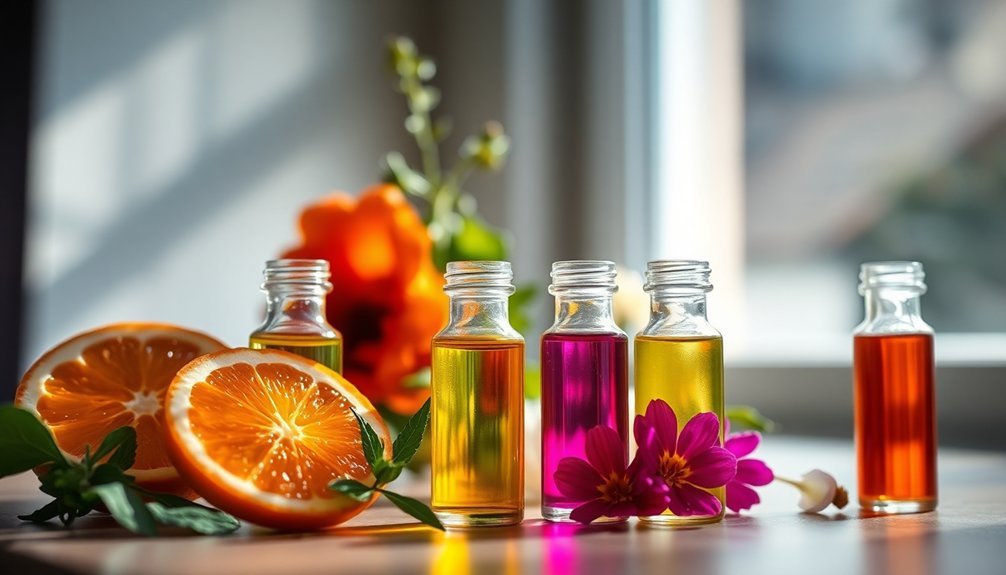
Why do perfume creators pay such careful attention to top notes? It's because these fragrance notes serve as your first impression of a scent, making them essential to a perfume's success. When you initially spray a perfume, top notes immediately capture your attention, lasting for the first 5-15 minutes of wear.
These initial scents, often composed of bright citrus oils like lemon, bergamot, or grapefruit, along with invigorating notes like peppermint and eucalyptus, set the tone for your entire fragrance experience.
They're carefully selected to provide brightness and freshness while hinting at the perfume's overall character. Most importantly, top notes must seamlessly evolve into the middle and base notes, creating a harmonious progression that keeps you engaged throughout your fragrance journey.
Understanding Top Note Characteristics and Duration
You'll experience a perfume's top notes within the first essential minutes of application, creating that important initial impression that either draws you in or pushes you away.
These bright, fresh scents typically last only 5-15 minutes before they begin fading into the middle notes, making their fleeting nature a key consideration in perfume selection.
Your awareness of this brief duration helps you understand why a fragrance's opening burst might differ greatly from its lasting character, allowing you to make better choices when selecting your signature scent.
First Impressions Matter Most
When you first experience a perfume, those fleeting initial moments shape your entire perception of the fragrance. That's why top notes play such an essential role in determining whether you'll fall in love with a scent or pass it by.
These initial scents, lasting only 5-15 minutes, create that important first impression that can make or break your connection with the perfume.
Think of citrus oils, peppermint, and eucalyptus – these fresh, light scents are specifically chosen to capture your attention immediately. They're your fragrance's opening statement, setting the tone for everything that follows.
While they may be temporary, their impact creates a lasting impression that influences your emotional response to the entire perfume experience.
In perfumery, as in life, you never get a second chance at a first impression.
Duration Affects Scent Impact
The short-lived nature of top notes directly shapes their impact on your fragrance experience. When you understand that these initial scents last only 5-15 minutes, you'll better appreciate how to maximize their effect through strategic fragrance layering.
- Top notes create powerful first impressions, setting the stage for your perfume's personality.
- Fresh, vibrant scents like citrus oils and mint deliver an immediate, energetic burst.
- The quick evaporation of top notes creates a dynamic shift into deeper fragrance layers.
- Effective layering requires careful consideration of how top notes fade into middle notes.
Selecting Complementary Top Notes for Your Blend
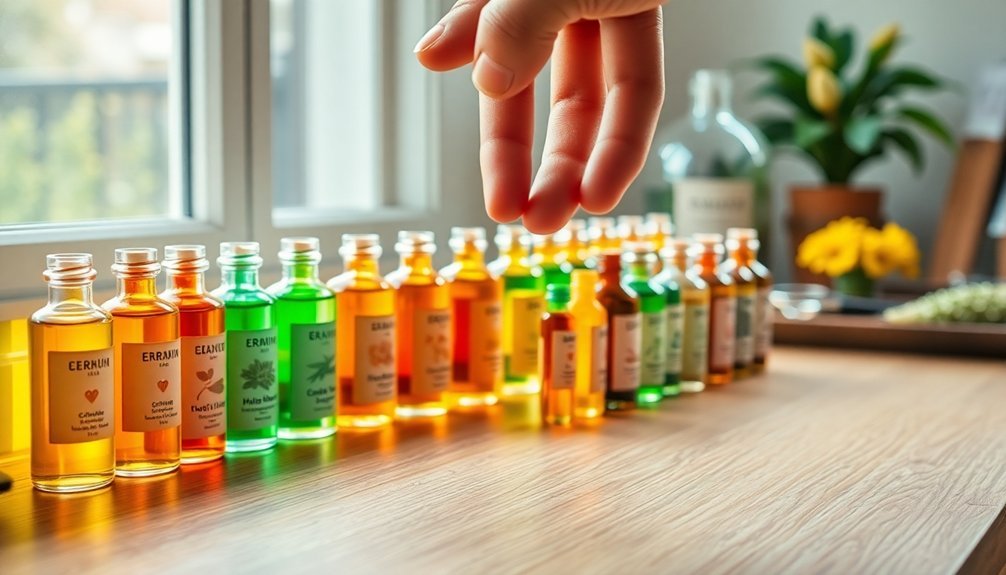
Selecting ideal top notes for your perfume blend requires careful consideration of how different scents interact and complement each other.
You'll want to focus on creating harmonious combinations that set the right tone for your fragrance's initial impression.
When choosing complementary top notes, you can pair citrus oils like lemon, bergamot, and grapefruit with fresh scents such as mint or eucalyptus.
These combinations work well together because they share similar aromatic profiles.
Remember not to overpower your blend by using too many dominant notes – instead, try pairing one vibrant top note with a milder one for better balance.
Before finalizing your selection, always test the top notes on your skin.
Since body chemistry affects how scents develop, this step guarantees your chosen combination delivers the intended fragrance experience.
Balancing Citrus and Herbal Top Notes
Successful perfume creation hinges on skillfully balancing citrus and herbal top notes to achieve an ideal opening accord. When you combine bright lemon or bergamot with grounding elements like peppermint or eucalyptus, you'll create a dynamic fragrance that captivates your senses.
- Citrus top notes deliver an uplifting burst that lasts 5-15 minutes, while herbal notes provide balance and stability.
- The combination creates a more complex scent profile that appeals to diverse preferences.
- Herbal notes help soften the sharp edges of citrus, resulting in a more harmonious blend.
- This layering technique establishes a strong foundation for your middle and base notes.
The Art of Layering Multiple Top Notes

When you're layering multiple top notes in your perfume, you'll create a more powerful and memorable first impression that captures attention immediately.
By combining complementary scents, such as pairing citrus oils with fresh herbals, you'll amplify the fragrance's opening impact while ensuring each note contributes to a harmonious whole.
Your carefully selected top note combinations will work together to establish a dynamic and evolving introduction that sets the stage for the rest of your perfume's journey.
Amplifying Initial Scent Impact
The delicate art of layering top notes transforms an ordinary fragrance into an extraordinary olfactory experience. When you combine multiple initial scents, you'll create a more powerful and memorable first impression that captures attention instantly.
By strategically layering complementary top notes, you're able to craft a signature scent that truly reflects your personality while ensuring a smooth transition into the middle notes.
- Blend citrus oils like Lemon and Bergamot with Peppermint to maximize freshness and vibrancy
- Create a dynamic opening that evolves gracefully as the fragrance develops
- Balance the composition to prevent any single note from becoming overwhelming
- Design a unique scent profile that maintains interest throughout the fragrance's development
This layering technique helps you achieve a more sophisticated and nuanced opening that sets your perfume apart from single-note fragrances.
Crafting Dynamic Opening Notes
Building upon the initial scent impact, mastering the art of layering multiple top notes opens up endless possibilities for creating distinctive fragrances.
You'll find that combining different elements from the fragrance family, such as citrus oils and revitalizing herbs, creates a dynamic and engaging opening that captures attention immediately.
When you layer your top notes strategically, you're crafting a complex symphony that plays out in the first 5-15 minutes of wear.
By blending bright citruses with invigorating herbs, you'll achieve a multidimensional introduction that sets your perfume apart.
This careful orchestration not only enhances the initial experience but also guarantees a smooth shift into the middle notes.
The result is a well-balanced fragrance that evolves beautifully while maintaining its vibrant character from the very first spray.
Creating Dynamic First Impressions Through Layering
Creating dynamic first impressions through fragrance requires mastering the art of top note layering, since these initial scents immediately capture attention and set expectations.
When you layer top notes effectively, you'll craft a signature scent that resonates deeply with both you and those around you.
- Combine citrus oils and peppermint to enhance freshness and create an enticing opening that draws people in
- Layer multiple top notes to guarantee your fragrance maintains its vibrancy during the vital first 5-15 minutes
- Build harmonious blends that appeal to diverse preferences, making your perfume more versatile
- Create memorable olfactory experiences by strategically combining different top notes for a dynamic evolution
Common Mistakes to Avoid When Layering Top Notes
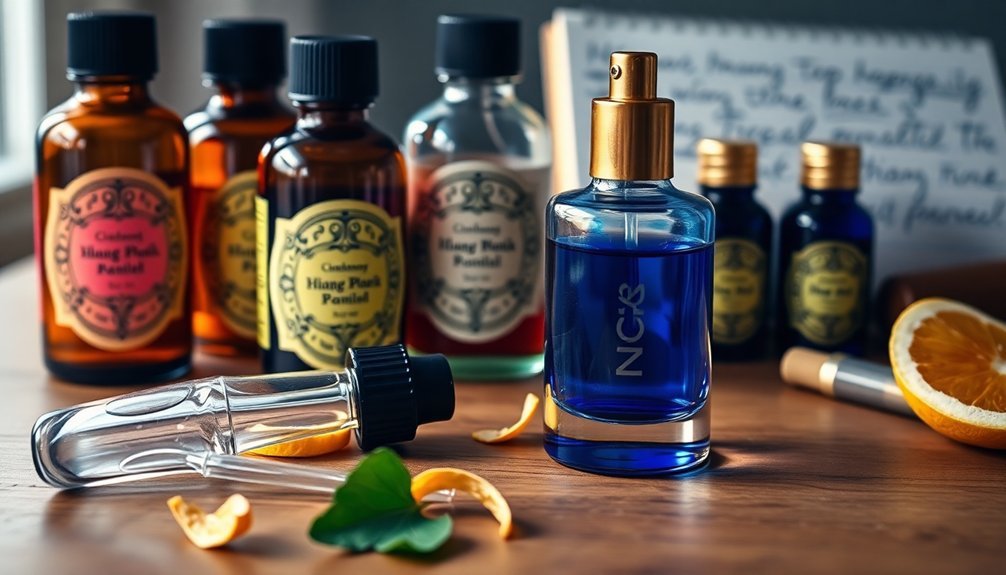
While layering top notes can elevate your fragrance, several common pitfalls can derail your perfume-making efforts. When you combine too many dominant citrus scents, you'll create chaos rather than harmony in your opening notes.
Similarly, rushing the process by not allowing each layer to settle can muddle the individual characteristics of your fragrance. Be mindful that top notes dissipate within 5-15 minutes, so you'll need to carefully consider how they'll interact with your middle and base notes as they fade.
Avoid using multiple fresh scents that compete rather than complement each other. Additionally, don't over-apply your top notes, as this will overwhelm the subsequent layers and prevent your fragrance from properly developing its full character and depth.
Top Note Combinations for Different Fragrance Families
Successful top note combinations stem from understanding how different fragrance families interact and complement each other. When you're creating a perfume, you'll want to carefully select top notes that enhance your chosen fragrance family while creating a memorable first impression.
- For fresh fragrances, combine citrus top notes like lemon and bergamot to create an uplifting, energetic opening.
- In aromatic compositions, blend peppermint and eucalyptus with woody top notes for a natural, invigorating effect.
- If you're working with floral fragrance families, pair neroli and lavender to achieve a romantic, soothing character.
- For fruity perfumes, mix yuzu or blood orange with floral elements to develop a vibrant, well-rounded scent.
These combinations will help you create balanced fragrances that evolve beautifully as they develop on the skin.
Measuring and Proportioning Top Notes Effectively
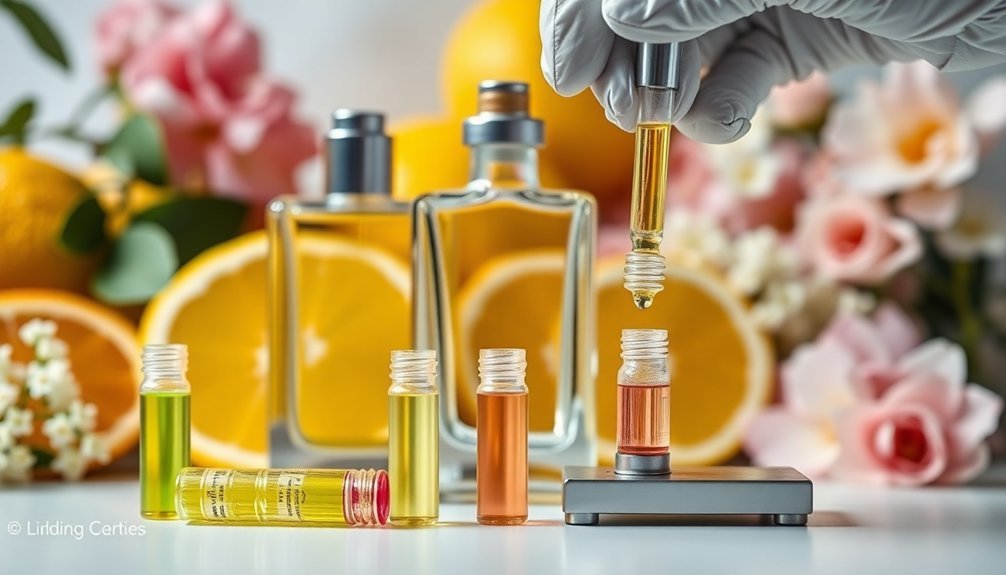
You'll want to start with precise dilution ratios of 20-30% for your top notes, carefully measuring each drop to maintain consistency throughout your perfume creation process.
Testing your combinations on fragrance strips helps you understand how the notes interact and evolve, allowing you to adjust proportions before committing to larger batches.
Begin with small test batches of 5-10ml before scaling up your successful formulations, ensuring that your chosen top notes maintain their intended impact and harmony with middle and base notes.
Precise Dilution Ratios Matter
Mastering precise dilution ratios can make or break your perfume's initial impression. When you're working with top notes, which typically comprise 20-30% of your fragrance, accuracy is vital for achieving a balanced composition that won't overwhelm the senses.
- Use a scale or pipette to guarantee consistent measurements for future batches.
- Pay attention to top notes' quick evaporation rate to avoid dominating other scent layers.
- Experiment with different ratios to discover unique scent combinations.
- Remember that precise dilution ratios affect how people perceive your entire fragrance.
You'll find that careful measurement of your top notes creates a more harmonious blend.
Balance Through Test Strips
Testing fragrances on paper strips provides an essential foundation for perfecting your top note combinations.
When you're developing your perfume blend, test strips help you evaluate how your chosen top notes interact and evolve over their brief 5-15 minute lifespan.
You'll be able to assess their immediate impact and make precise adjustments to create the right balance.
Start Small, Scale Up
Now that you've evaluated your top notes on test strips, precise measurement becomes the key to successful layering.
Begin with 20-30% of your total fragrance blend for top notes, using a dropper or pipette to guarantee accuracy. You'll want to methodically increase amounts by 5-10% until you achieve your desired scent profile.
- Start with small quantities to avoid overwhelming your blend
- Use precise measuring tools like droppers or pipettes
- Document each measurement and combination you try
- Monitor how the scent shifts into middle notes
Since top notes evaporate within 5-15 minutes, you'll need to measure carefully to create a smooth progression.
Your careful attention to proportions will help you develop a signature fragrance that opens beautifully and evolves naturally.
Keep detailed records of your successful combinations for future reference.
The Science Behind Top Note Evaporation Rates

While perfume creation may seem like pure artistry, the science of molecular evaporation plays an essential role in how top notes perform.
When you apply your perfume, the top notes are the first to greet your senses, but they won't stick around for long. These volatile components typically evaporate within 5-15 minutes of application, with smaller molecules dissipating even faster. That's why citrus and mint scents, despite their bold entrance, quickly fade.
The evaporation rates of top notes are precisely why perfumers carefully select ingredients like lemon and bergamot for their initial impact. As these notes fade, they gracefully shift into the middle notes, which last 20-60 minutes.
Understanding these evaporation rates helps create well-balanced fragrances that evolve beautifully on your skin.
Seasonal Considerations for Top Note Selection
Choosing the right top notes requires careful attention to seasonal changes in both weather and mood.
You'll find that warmer months call for light, invigorating scents like lemon and bergamot, while colder seasons benefit from spicier, warming notes like cinnamon and ginger.
When you layer these scents together, consider how they'll complement the deeper middle and base notes throughout the day.
- Spring/Summer: Opt for clean, citrusy top notes for daytime wear
- Fall/Winter: Select rich, spicy notes for cozy evening experiences
- Shifting Seasons: Mix fresh and warm notes to adapt to changing weather
- Year-round: Verify your top notes align with the occasion and time of day
Remember that top notes last only 5-15 minutes, so select ones that quickly establish your desired seasonal mood before gracefully fading into the heart of your fragrance.
Testing and Adjusting Your Top Note Layers
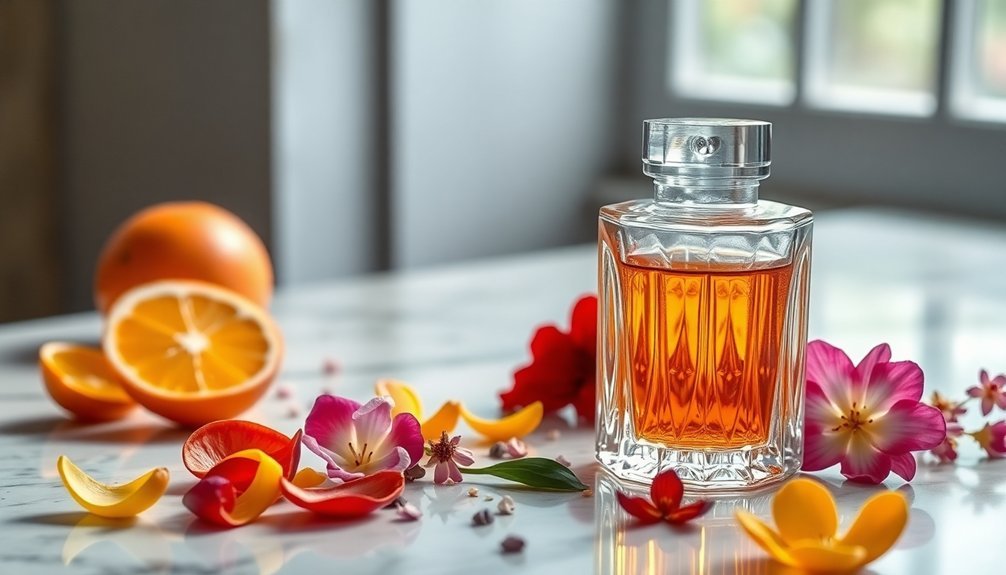
Testing your layered top notes requires a methodical approach to guarantee they harmonize effectively. You'll need to apply each note separately on scent strips and allow them to dry before evaluating their interactions. Since top notes evaporate within 5-15 minutes, you must assess them immediately after application.
| Testing Phase | What to Check | When to Check |
|---|---|---|
| Initial | Individual scents | Immediately |
| Interaction | Blending effects | After 5 minutes |
| Evolution | Middle note progression | 10-15 minutes |
| Documentation | Record observations | Throughout process |
Keep a fragrance journal to track your observations and adjustments. Test your combinations at different times of the day to understand how they evolve and interact with middle notes. Remember to adjust proportions based on intensity to create a balanced opening that enhances your overall fragrance composition.
Frequently Asked Questions
What Is the Purpose of Layering Perfume?
You'll create a unique, personalized scent by combining complementary fragrances. Layering adds depth, complexity, and longevity to your perfume while letting you craft a custom scent that evolves throughout the day.
Why Do Perfumes Have Top Notes?
Top notes give you the first impression of a perfume. They're designed to grab your attention with bright, fresh scents that quickly evaporate, leading you into the fragrance's deeper layers as they develop.
How to Layer Perfumes Based on Notes?
Start with base notes, then add middle notes, and finish with top notes. You'll want to let each layer dry before applying the next. This creates depth and guarantees your fragrance develops properly.
What Is a Fragrance Layering Topper?
A fragrance layering topper is your first layer of scent, featuring light, invigorating notes like citrus or mint. You'll apply it before other fragrances to create an initial burst of brightness and enhance overall complexity.
In Summary
By layering your top notes carefully, you'll create a more complex and memorable opening to your perfume that evolves beautifully over time. Remember to test different combinations, adjust your proportions, and consider how each note interacts with the others. Whether you're working with citrus, herbs, or other volatile scents, thoughtful layering will elevate your fragrance from simple to sophisticated, making it uniquely yours.

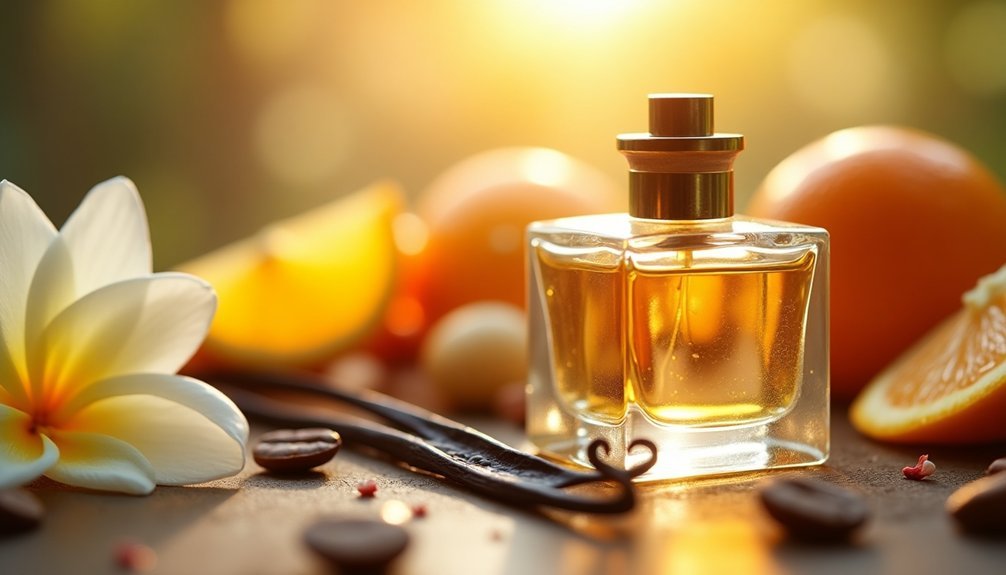



Leave a Reply